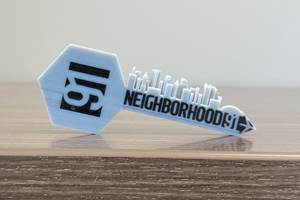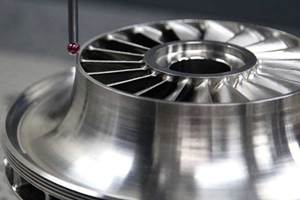Share
Read Next
In theory, 3D printing is the perfect production method for distributed manufacturing. Digital files can travel easily, without the challenges of shipping cargo across borders or around the world. A 3D printer equipped with the proper material and capabilities can print any design, without the need for the proper mold, cutting tool or other fixturing. Printers can be located anywhere, and production shifted between them at will.
This is the distributed manufacturing vision, but its realization faces roadblocks. From the designer or OEM’s standpoint, distributing a 3D printable file to far-flung manufacturers or individual users comes with risk — the risk that the file may be corrupted or tampered with; that more prints than are authorized will be made; and that intellectual property will be stolen. Designers have been largely unable to control how many times a design might be printed once it is sold; this means they are often forced to sell designs at higher prices regardless of whether the manufacturer intends to print one or thousands.
The party receiving such files therefore may have taken a financial risk in purchasing them, and may also have doubts about their authenticity, origins or completeness. (Any millennial who remembers the questionable music files available on peer-to-peer sites in the early 2000s can likely relate.)
Blockchain is the possible solution, offering a way to establish trust on both sides, says Johannes Schweifer, founder and CEO of CoreLedger. With locations in Liechtenstein and Switzerland, CoreLedger provides affordable blockchain solutions to businesses. “We allow companies of all sizes to use blockchain without needing their own blockchain development teams,” Schweifer says. Through a combination of ready-made blockchain infrastructure and customizations specific to each use case, CoreLedger customers can implement the technology to document and tokenize assets, govern the use of digital artifacts, make items tradeable, build smartphone apps and much more.
CoreLedger previously partnered with and provided the base blockchain infrastructure to Ambitorio, a Swiss company that supports secure file exchange based on blockchain technology. In 2021, Ambitorio became involved in a project from Interreg, a European Union initiative that supports cross-border collaborative projects to address common challenges among EU nations. Together they collaborated with the other members of an Interreg-funded initiative to find new business models with 3D printing. The group created a solution for distributing additive manufacturing files that accomplishes three main objectives:
- Securing 3D printable files via file hashing. A cryptographic algorithm generates a unique hash, or fingerprint, for each file based on its contents. The blockchain does not store the files themselves, but the hashes that verify their authenticity. No two files will have the same hash unless they are absolutely identical; changing anything about the data will result in a different hash. While this technique is not entirely new, the collaborators iterated on the technology to easily turn a 3D printable file into a digital artifact on the blockchain. Each artifact’s unique fingerprint makes it easy to verify proof of authenticity and uniqueness.
- Protecting access to the data. In this system 3D printable files are encrypted and the access right is tokenized and tied to the stored hashes. When a printable object is shared, the receiver obtains a token that enables access. It is impossible to decrypt the file without this token asset, which ensures that only authenticated parties can use the 3D printable data.
- Accounting for printing runs. This was the most challenging part of the project, Schweifer says, but one of the most valuable pieces to figure out. The blockchain solution developed makes it possible to restrict the number of prints that can be made from a given asset by requiring each print to “cost” a token. (But, recognizing that scrap is often a reality of production, the system makes exceptions for parts that fail a quality check; if the blockchain data can prove that a certain part is bad, the manufacturer can get the leeway to print a replacement.) Companies can do production runs based on these tokens rather than paying for full access to own a particular file, which makes 3D printing more viable and affordable for both commercial and non-commercial users.
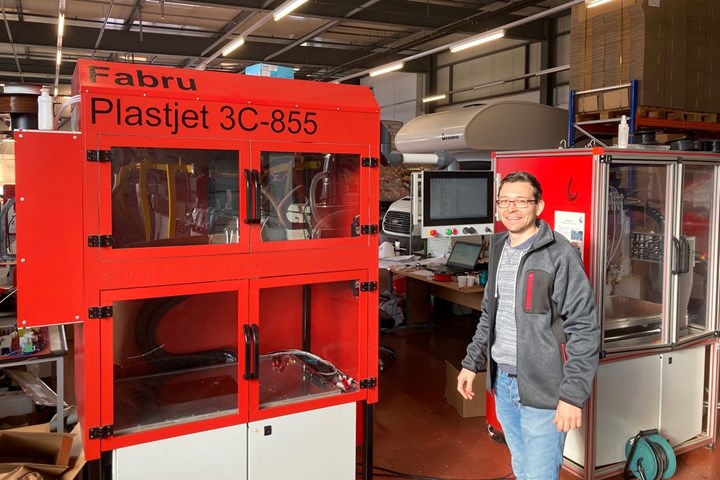
3D printer manufacturer and service provider Fabru served as the pilot site for testing of the blockchain solution. Photo Credit: Ambitorio
To test the solution CoreLedger and Ambitorio collaborated with Fabru GmbH, a Swiss company that manufactures 3D printers and filament in addition to providing production services. As the pilot site, Fabru integrated the blockchain system with its Plastjet 3C-855 fused filament fabrication (FFF) 3D printer by way of a Beelink mini PC. The company has successfully used the solution to send printable files to the machine and control batch sizes of those parts.
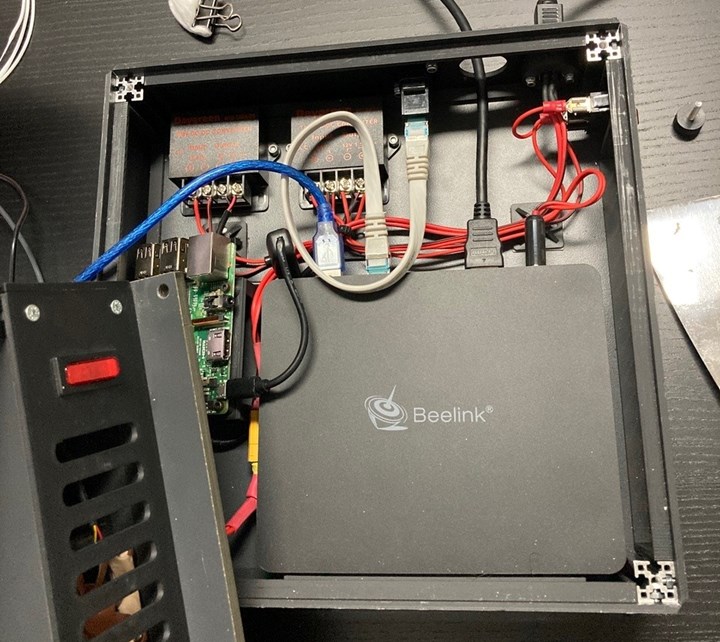
Existing 3D printing equipment will need to be retrofitted to utilize the blockchain solution; however, CoreLedger and Ambitorio are in conversations with printer manufacturers about including this integration from the beginning. Photo Credit: Ambitorio
Benefits to 3D Printing with Blockchain
Implementing a system like this could have advantages to both industrial manufacturers and the consumer world. On the industrial side, blockchain-protected 3D printing files ensure trust between creator and manufacturer. The designer, brand or OEM knows that their IP will be protected, and the manufacturer is assured that it is receiving authentic, unadulterated files to print from. “It becomes about trusting the token, not the person who sells the token,” Schweifer says.
Having such a system in place alongside 3D printing capability could help establish local manufacturing as an attractive option; rather than risk sending IP overseas where parts or products will be made with expensive tooling, a manufacturer can instead opt for local production near customers. If trustworthy, protected 3D printable files exist, spare parts will become easier to obtain because they will not need to be made, shipped and stored but can be produced locally as needed. Localizing manufacturing brings sustainability benefits as well; producing near the need reduces transportation and associated CO2 emissions, while on-demand production avoids the creation of waste. More local manufacturing enabled by blockchain may also help protect local production jobs and even expand these opportunities.
(The sustainability objections to blockchain, by the way, are mostly associated with mining of Bitcoin cryptocurrency, one specific and energy-intensive use of blockchain technology that depends on the proof-of-work consensus mechanism. Other activities supported by blockchain use different mechanisms such as proof of stake and proof of authority which consume far less energy.)
But on the private user side, the solution has the potential to expand democratization of 3D printing, in the sense that it could give home and independent 3D printing users sanctioned access to authenticated designs. Though files would come at a price, their availability might help alleviate the design barrier to entry; a 3D printing operator would not need to be an expert in design or design for additive manufacturing to successfully manufacture goods and parts. Makers wishing to print objects protected by copyright might be able to legitimately purchase these designs through such a system. OEMs and consumer brands may even be motivated to sell printable files for replacement parts, customizations and accessories, or even exclusive product lines to customers, knowing their IP will be protected via blockchain.
Next Links in the Blockchain
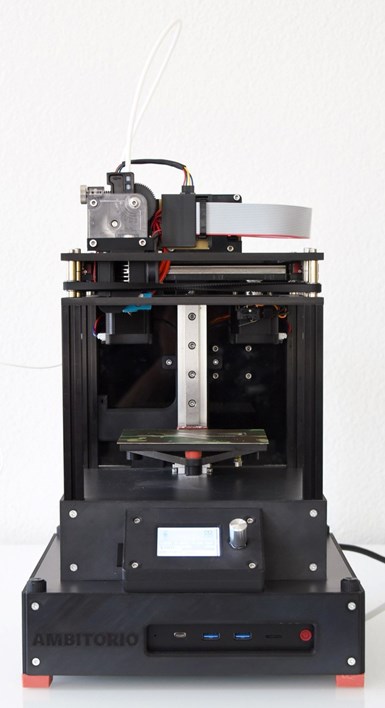
A 3D printer equipped with hardware and software supplied by Ambitorio to integrate blockchain-enabled manufacturing. Photo Credit: Ambitorio
Since its kickoff in 2019, the Interreg project has completed its initial objectives and established that the system works via the Fabru pilot site. The collaborators have begun to have conversations with other 3D printer manufacturers about how to integrate this solution into their equipment. But growing implementation of blockchain will not be the end of this initiative.
“The next stage is to make everything tradeable,” Schweifer says. The intersection of 3D printing and blockchain creates the opportunity to treat 3D printable objects like tokens (fungible or not) that can be bartered. For example, if a manufacturer purchases the ability to 3D print 1,000 units but only makes 900, the remaining 100 could potentially be bartered or transferred to another manufacturer. Expanding beyond 3D printing, machine utilization could be tokenized in a similar fashion — manufacturers could market and sell available machine time in the form of tradeable tokens.
For now, there is more work to do. “The use cases are in the making,” Schweifer says. “We are maybe two years ahead of broad implementation.”
Related Content
Big Metal Additive: The Difference Between a Shape and a Part Is Quality
Preparing to scale directed energy deposition to ongoing full production is not a technological challenge: DED is ready. But it is an organizational challenge, says the company founder. Here is what it means to implement a quality system.
Read MoreWhat Is Neighborhood 91?
With its first building completely occupied, the N91 campus is on its way to becoming an end-to-end ecosystem for production additive manufacturing. Updates from the Pittsburgh initiative.
Read MoreVelo3D Founder on the 3 Biggest Challenges of 3D Printing Metal Parts
Velo3D CEO and founder Benny Buller offers this perspective on cost, qualification and ease of development as they apply to the progress of AM adoption in the future.
Read MoreThis Year I Have Seen a Lot of AM for the Military — What Is Going On?
Audience members have similar questions. What is the Department of Defense’s interest in making hardware via 3D printing over conventional methods? Here are three manufacturing concerns that are particular to the military.
Read MoreRead Next
Where Blockchain and 3D Printing Converge, Distributed Manufacturing Can Thrive
Decentralizing production through additive manufacturing can bring numerous benefits, but these can only be realized through trust. VeriTX is building a platform to secure a trusted digital supply chain for aerospace and beyond.
Read MoreCrushable Lattices: The Lightweight Structures That Will Protect an Interplanetary Payload
NASA uses laser powder bed fusion plus chemical etching to create the lattice forms engineered to keep Mars rocks safe during a crash landing on Earth.
Read MoreBike Manufacturer Uses Additive Manufacturing to Create Lighter, More Complex, Customized Parts
Titanium bike frame manufacturer Hanglun Technology mixes precision casting with 3D printing to create bikes that offer increased speed and reduced turbulence during long-distance rides, offering a smoother, faster and more efficient cycling experience.
Read More

.jpg;width=70;height=70;mode=crop)













